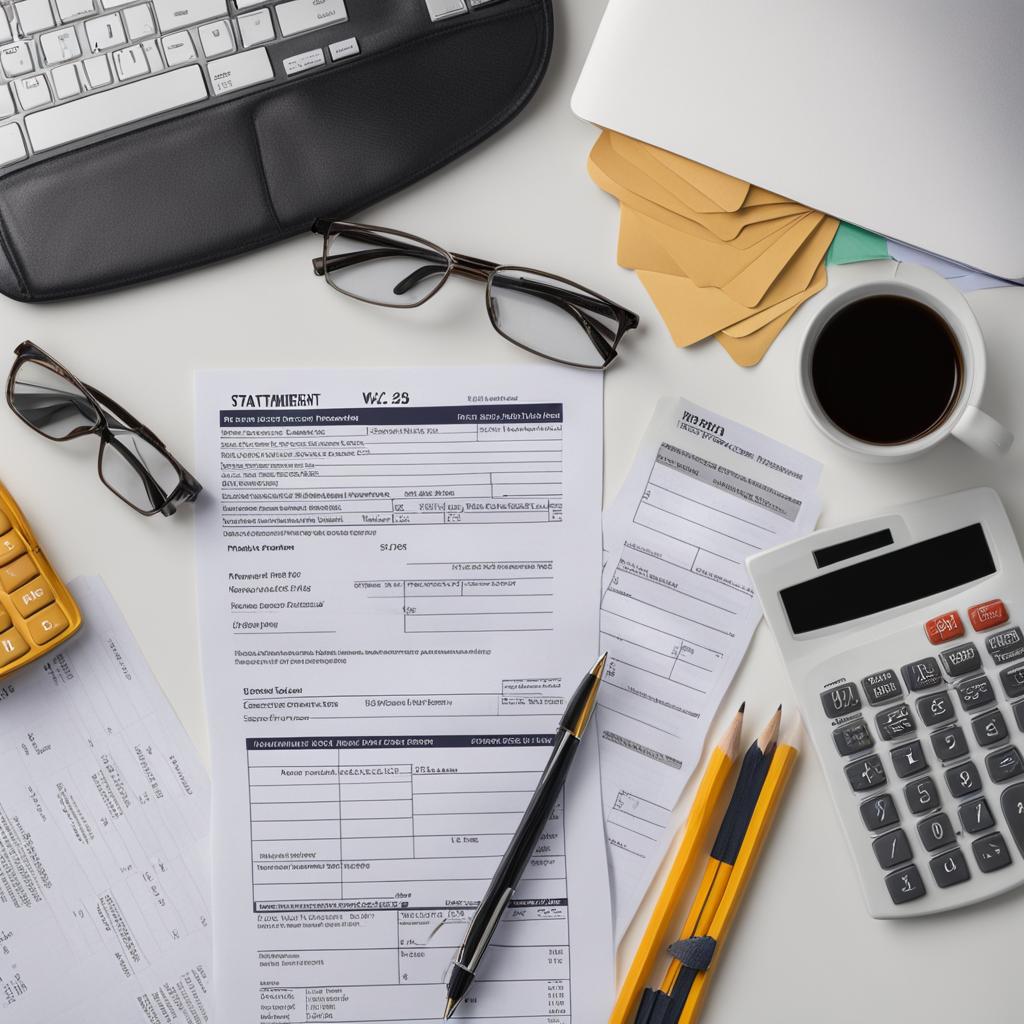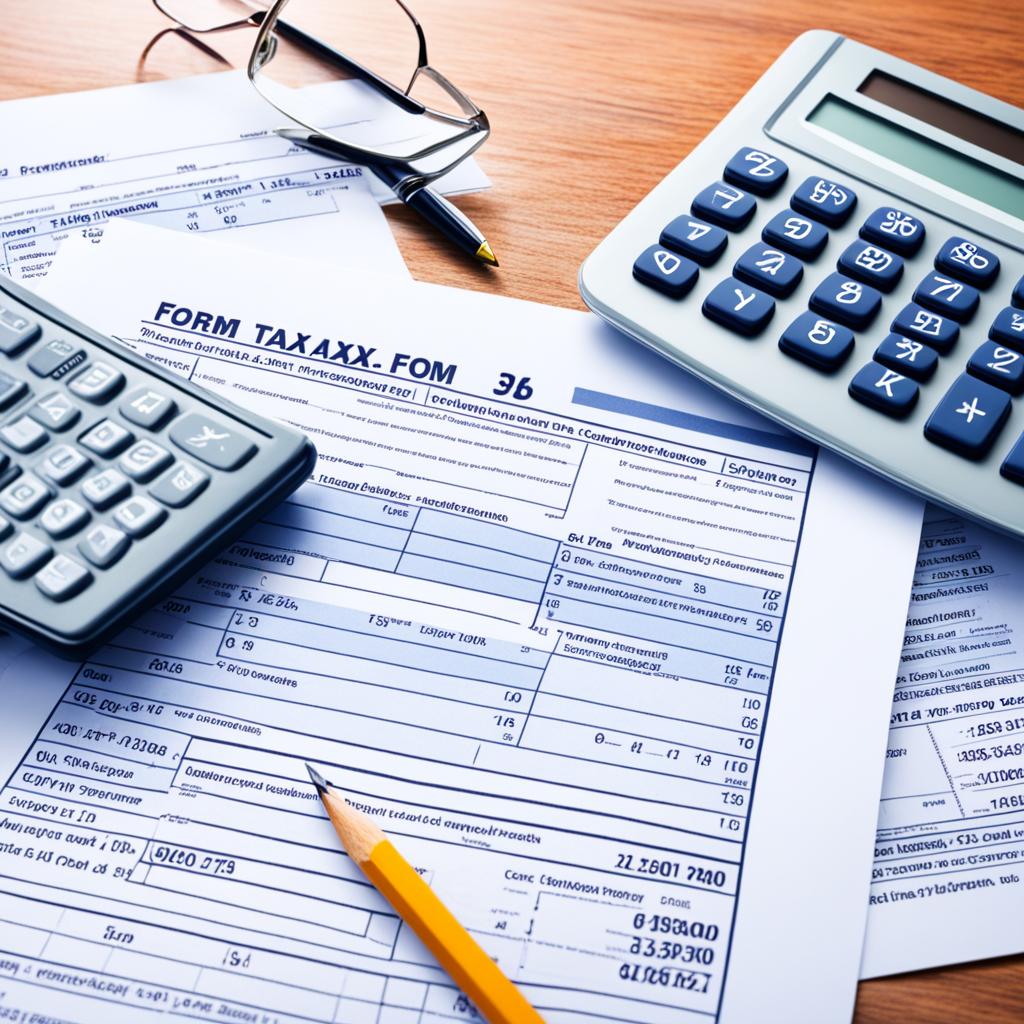Are you filing your taxes for the first time or working part-time and need guidance on how to navigate the tax season? Tax preparation can seem daunting, but with the right knowledge and resources, you can simplify the process. In this guide, I’ll walk you through the essential steps of tax filing, including important deadlines, deductions, and credits.
Key Takeaways:
- Understand the basics of tax preparation for beginners.
- Be aware of important tax filing deadlines to avoid penalties.
- Maximize deductions and credits to minimize your tax liability.
- Consider using tax software or hiring a tax preparer for assistance.
- Stay informed about tax law changes and resources for future tax seasons.
Whether you’re a beginner or just looking to refresh your tax knowledge, this guide will provide you with the essential information and tips to make tax filing less daunting. By following these steps and utilizing available resources, you can confidently complete your tax preparation and file your taxes accurately and efficiently.
Determine if You Need to File Taxes
Before diving into the tax preparation process, it’s important to determine whether or not you need to file a tax return. Several factors come into play, including your income, filing status, and age. But even if you’re not required to file, it’s still worth considering, as you may qualify for tax breaks or refundable credits that could put money back in your pocket.
Remember, filing taxes isn’t just about meeting your legal obligations; it’s also an opportunity to maximize your financial benefits.
One key aspect to consider is whether you have earned income, such as wages or self-employment income. If your income falls below a certain threshold, you may not need to file a tax return. For example, in 2024, the IRS set the filing requirement at $12,000 for single individuals under the age of 65.
If you have dependents, it’s important to note that their income can also affect your filing requirement. The IRS has specific rules regarding tax dependents, and understanding these rules will help you determine whether you need to file and whether you can claim certain tax benefits.
Moreover, certain tax credits, such as the Earned Income Tax Credit (EITC) and the Child Tax Credit, can provide substantial financial relief for eligible taxpayers. These credits are refundable, which means they can reduce your tax liability and even result in a refund if the credits exceed the amount you owe.
So, take the time to evaluate your financial circumstances and consider the potential benefits of filing a tax return. It could lead to valuable tax deductions, credits, and a boost to your overall financial well-being.
Am I Required to File a Tax Return?
Here is an overview of the filing requirements based on your filing status and age for the tax year 2024:
| Filing Status | Age | Income Threshold for Filing Requirement |
|---|---|---|
| Single | Under 65 | $12,000 |
| Married Filing Jointly | Both spouses under 65 | $24,000 |
| Married Filing Jointly | One spouse 65 or older | $25,300 |
| Married Filing Jointly | Both spouses 65 or older | $26,600 |
| Head of Household | Under 65 | $18,000 |
| Head of Household | 65 or older | $19,600 |
| Qualifying Widow(er) with Dependent Child | Under 65 | $24,000 |
| Qualifying Widow(er) with Dependent Child | 65 or older | $25,300 |
| Married Filing Separately | Any age | $5 |
Keep in mind that these income thresholds are subject to change each year. Make sure to check the latest IRS guidelines or consult a tax professional for the most up-to-date information.
How Can I Benefit from Tax Credits?
Claiming tax credits can significantly reduce your tax liability and potentially increase your tax refund. Here are two important tax credits to consider:
- Earned Income Tax Credit (EITC): The EITC is designed to assist low- to moderate-income individuals and families. It is a refundable tax credit, meaning that it can not only reduce your tax bill but also provide a refund if the credit exceeds the amount you owe. To qualify for the EITC, you must meet certain income and filing status requirements. The credit amount depends on your earned income and the number of qualifying children you have. Make sure to review the IRS guidelines to determine if you are eligible for this valuable credit.
- Child Tax Credit: If you have qualifying children, you may be eligible for the Child Tax Credit. This credit provides a dollar-for-dollar reduction in your tax liability. For each qualifying child under the age of 17, you may be eligible for a credit of up to $2,000. The Child Tax Credit is partially refundable, allowing you to receive a refund if the credit exceeds your tax liability. Consult the IRS guidelines to confirm your eligibility for this credit.
It’s worth noting that both the EITC and the Child Tax Credit have specific eligibility requirements based on income, filing status, and the number of qualifying children. Understanding these requirements is crucial when determining whether you need to file a tax return and can benefit from these credits.
Now that you understand the importance of determining your filing requirement and exploring potential tax credits, you’re ready to proceed with your tax preparation journey. Let’s dive deeper into tax deadlines, the various methods of filing your taxes, and the factors that influence how your taxes are calculated.
Know the Tax Deadlines and Dates
When it comes to filing taxes, it’s essential to stay informed about the important tax deadlines and dates. Marking these milestones on your calendar will ensure that you meet the necessary requirements and avoid any potential penalties or fees.
The tax filing season typically begins in late January, giving you ample time to gather the required documents and prepare your tax return. However, the most critical date to remember is the tax return due date, which falls on April 15th. This is the deadline by which you must file your tax return with the Internal Revenue Service (IRS) for the previous tax year.
If you find yourself running short on time, you have the option to request a tax extension. Obtaining a tax extension will give you additional time to prepare and file your tax return. The extended due date is typically October 15th.
It’s crucial to note that a tax extension only provides more time to file your taxes, not to pay the taxes you owe. If you anticipate owing taxes, it’s important to estimate and submit your payment by the original tax return due date to avoid any late-payment penalties.
Failing to file your taxes by the due date can result in a late-filing penalty imposed by the IRS. Additionally, if you owe taxes and don’t submit your payment on time, you may incur a late-payment penalty. It’s always best to file on time and pay what you can to minimize any potential fees or charges.
Stay on top of these tax deadlines and dates to ensure a smooth and stress-free tax filing experience. Planning ahead, seeking assistance if needed, and submitting your taxes on time can help you avoid unnecessary fees and penalties.
Choose How to File Your Taxes
When it comes to filing your taxes, you have three main options: using tax software, hiring a tax preparer, or filling out the forms manually. Each method has its own benefits and considerations, so let’s explore them in more detail.
1. Tax Software
Using tax software is a popular and convenient choice for many taxpayers. There are various tax software options available, both free and paid, that can simplify the tax preparation process. One notable option is the IRS Free File program, which provides access to free tax software from reputable providers for eligible individuals. With tax software, you can easily navigate through different tax forms, input your financial information, and let the software handle the calculations. It also helps you identify potential deductions and credits that you may qualify for, ensuring you don’t miss out on any tax-saving opportunities.
2. Hiring a Tax Preparer
If you prefer personalized assistance and want to ensure your tax return is accurate and optimized for potential benefits, hiring a tax preparer is a good option. A tax preparer is a qualified professional who can guide you through the tax filing process, provide expert advice, and help you navigate complex tax situations. They are especially beneficial if you have a more complex financial situation involving businesses, investments, or rental properties. When choosing a tax preparer, consider working with a certified public accountant (CPA) or an enrolled agent who has extensive knowledge and experience in tax preparation.
3. Filling out Forms Manually
Filling out the forms manually is the traditional way of filing taxes. While it may take more time and effort, it can be a viable option if you have a simple tax situation and prefer a hands-on approach. Filling out the forms manually allows you to have full control over the process and ensures that you understand each component of your tax return. However, keep in mind that this method may not provide the same level of accuracy and efficiency as tax software or working with a tax preparer, especially if you’re not familiar with the tax code.
“Choosing how to file your taxes depends on your preference, complexity of your financial situation, and the level of guidance you require.”
Regardless of the method you choose, it’s important to gather all the necessary tax documents, such as W-2s, 1099s, and receipts for deductions. This will ensure that you have the information needed to complete your tax return accurately.
Now that you’re aware of the different options available, you can select the method that best suits your needs. Whether you decide to use tax software, hire a tax preparer, or fill out the forms manually, the goal is to file your taxes accurately and efficiently, maximizing potential deductions and credits along the way.
Example Table: Comparison of Filing Methods
| Tax Software | Tax Preparer | Manual Filing | |
|---|---|---|---|
| Convenience | High | High | Variable |
| Cost | Free or Paid | Varies | Free |
| Accuracy | High | High | Depends on individual’s knowledge |
| Expert Guidance | Limited | Extensive | N/A |
| Complexity Handling | Good for most situations | Excellent for complex situations | Simple situations only |
Understand How Your Taxes Are Determined
Taxes are determined based on your taxable income. The federal tax system follows a progressive tax system, meaning that higher incomes are subject to higher tax rates. To better understand this concept, let’s take a look at tax brackets.
Tax brackets are the ranges of income to which specific tax rates apply. There are several tax brackets, each with its own corresponding tax rate. As your income increases, you move into a higher tax bracket, and a higher tax rate is applied to the portion of your income within that bracket.
In addition to federal income tax rates, it’s important to note that most states also have their own state income taxes. These state taxes may have different rates and rules compared to federal taxes. It’s essential to familiarize yourself with the specific tax laws of your state to accurately calculate your overall tax liability.
Understanding how taxes are calculated empowers you to make informed decisions when it comes to tax planning, deductions, and credits. Let’s dive deeper into the progressive tax system and explore how federal income tax rates are structured in the table below:
| Taxable Income | Tax Rate |
|---|---|
| $0 – $9,950 | 10% |
| $9,951 – $40,525 | 12% |
| $40,526 – $86,375 | 22% |
| $86,376 – $164,925 | 24% |
| $164,926 – $209,425 | 32% |
| $209,426 – $523,600 | 35% |
| Over $523,600 | 37% |
Note that these rates apply to taxable income after deducting any available tax deductions and exemptions. Your actual tax liability may vary based on your specific financial circumstances. It’s always recommended to consult with a tax professional or use tax software to accurately determine your tax liability.
By understanding how your taxes are determined, you can effectively plan your finances and identify opportunities for tax optimization. Next, we’ll discuss how to gather the necessary information for filing your taxes in Section 6.
Gather Tax Filing Information
Before filing your taxes, it’s important to gather all the necessary information and documents to ensure a smooth tax filing process. Here are the key items you’ll need:
Proof of Income
To accurately report your income, gather all relevant documents such as:
- W-2 forms: These forms show your earnings from an employer.
- 1099 forms: If you received income from freelance work or contract jobs, you’ll need these forms.
Tax-Deductible Expenses
If you have expenses that may be tax-deductible, keep records and documents supporting those expenses. Some common examples include:
- Receipts for business-related expenses
- Records of medical expenses
- Documents related to education expenses
Tax Credits
If you qualify for tax credits, gather the necessary documents to claim them. Examples of tax credits include:
- Child Tax Credit documents
- Earned Income Tax Credit (EITC) records
- Education-related credit documents
Tax Documents
Having your tax documents organized will help streamline the filing process. Some key documents to gather include:
- Last year’s tax returns
- Form 8606 for IRA contributions
- Form 1095-A for health insurance
By gathering all the necessary information and documents, you’ll ensure that you have everything you need to accurately complete your tax filing. Having organized records will help you maximize deductions, credits, and potential tax savings.
| Tax Filing Information Checklist |
|---|
| Proof of Income |
| – W-2 forms |
| – 1099 forms |
| Tax-Deductible Expenses |
| – Receipts for business expenses |
| – Records of medical expenses |
| – Documents related to education expenses |
| Tax Credits |
| – Child Tax Credit documents |
| – Earned Income Tax Credit (EITC) records |
| – Education-related credit documents |
| Tax Documents |
| – Last year’s tax returns |
| – Form 8606 for IRA contributions |
| – Form 1095-A for health insurance |
Organize Your Tax Preparation
To streamline your tax preparation process, it’s essential to stay organized and have a clear plan in place. By following a tax preparation checklist and organizing your tax documents, you can ensure a smooth and efficient filing experience.
Create a Tax Preparation Checklist
Start by creating a tax preparation checklist to keep track of the necessary documents and information you need for filing your taxes. This checklist will serve as a guide, ensuring that you don’t miss any crucial steps along the way. Here are some items that you may want to include:
- W-2 forms or 1099 forms for reporting income
- Receipts for deductible expenses
- Records of any tax credits you may be eligible for
- Last year’s tax returns for reference
Having a comprehensive checklist will help you gather all the required paperwork and avoid any last-minute stress or confusion.
Organize Your Tax Documents
Once you have your checklist, it’s time to organize your tax documents. Categorize them based on the types of income, deductions, and credits you plan to claim. This will make it easier to locate specific documents when needed and ensure that nothing gets overlooked during the filing process.
Consider using folders or envelopes to keep your documents organized. Label each folder or envelope with the corresponding category, such as “Income,” “Deductions,” or “Credits.” This way, you can quickly find the documents you need when it’s time to fill out your tax forms.
Choose the Correct Filing Status
When using tax software to file your taxes, ensure that you select the correct filing status. Your filing status can have a significant impact on your tax liability, so it’s crucial to choose the one that accurately reflects your situation. Common filing statuses include:
- Single
- Married filing jointly
- Married filing separately
- Head of household
Choosing the correct filing status ensures that you take advantage of any applicable tax deductions or credits that are associated with your marital status and household situation.

By following these steps and organizing your tax preparation, you can simplify the tax filing process and minimize any potential issues or errors. Remember, staying organized and having all the necessary documents in order is key to a successful and stress-free tax season.
Maximize Your Deductions and Credits
When it comes to taxes, maximizing your deductions and credits is key to reducing your overall tax liability. Deductions lower your taxable income, while credits directly lower the amount of tax you owe. To ensure you’re taking advantage of all available tax breaks, consider the following:
Itemizing Deductions vs. Standard Deduction
One important decision you’ll need to make is whether to itemize your deductions or take the standard deduction. Prior to recent tax reforms, itemizing deductions was often beneficial for many taxpayers, as it allowed them to claim deductions for expenses like mortgage interest, state and local taxes, and charitable contributions. However, the standard deduction has significantly increased, making it a more attractive option for many individuals.
“Itemizing deductions can be advantageous if your itemized deductions exceed the standard deduction amount.”
Here’s a breakdown of the standard deduction amounts for the current tax year:
| Filing Status | Standard Deduction Amount |
|---|---|
| Single | $12,550 |
| Married Filing Jointly | $25,100 |
| Head of Household | $18,800 |
| Married Filing Separately | $12,550 |
If your itemized deductions exceed these amounts, then it might be advantageous to itemize your deductions. However, if your itemized deductions fall below the standard deduction, it’s generally more beneficial to take the standard deduction.
Available Tax Deductions and Credits
Additionally, there are various tax deductions and credits that can further reduce your tax liability. Some common deductions include:
- Mortgage interest
- State and local taxes
- Student loan interest
- Medical expenses
- Charitable contributions
On the other hand, tax credits provide a dollar-for-dollar reduction of your tax bill. Some popular tax credits include:
- Child Tax Credit
- Earned Income Tax Credit
- American Opportunity Credit
- Saver’s Credit
“By knowing which deductions and credits you’re eligible for, you can significantly lower the amount of taxes you owe.”
Gathering the necessary documentation and understanding the requirements for each deduction and credit can help you claim them accurately. Consulting a tax professional or using tax software can provide guidance to ensure you don’t miss out on any potential tax savings.
Summary
Maximizing your deductions and credits is crucial for reducing your tax liability. Whether you choose to itemize deductions or take the standard deduction, it’s important to carefully evaluate your options based on your individual circumstances. Additionally, staying informed about available tax deductions and credits can help you take advantage of all eligible tax breaks. Remember, deductions reduce your taxable income, while credits directly lower your tax bill.
“By understanding the deductions and credits available to you, you can effectively minimize your tax liability and keep more money in your pocket.”
File Your Taxes Online
Filing your taxes online is a convenient and accurate way to manage your tax preparation. By choosing a reliable tax software provider that suits your needs, you can streamline the filing process and ensure that all necessary information is entered correctly. Tax software guides you through each step, prompting you to enter relevant details, performing necessary calculations, and helping you maximize deductions and credits.
Electronic filing offers several advantages. It allows for the submission of your tax return directly to the IRS, eliminating the need to mail a physical copy. Electronic filing is also faster, reducing the processing time for your tax return. Additionally, opting for direct deposit for your refund means you’ll receive your money more quickly and directly into your bank account.
When filing your taxes online, make sure to gather all the required documents and information beforehand. This includes your W-2 forms, 1099 forms, and any other tax-related documents. Having everything organized and ready to go will ensure a smooth and efficient filing process.
Advantages of Filing Taxes Online:
- Convenience and accuracy
- Guidance through the filing process
- Prompting for required information
- Performing necessary calculations
- Maximizing deductions and credits
“Filing your taxes online saves time and ensures accurate submission of your tax return, maximizing your potential refunds.”
Make the most of technology and the convenience it offers by filing your taxes online. Take advantage of tax software and electronic filing to streamline the process and expedite your refund. By embracing these digital solutions, you’ll find that filing your taxes becomes a manageable and efficient task.
Consider Hiring a Tax Preparer
If you prefer to work with a professional, consider hiring a tax preparer or a certified public accountant (CPA). They can offer expert advice, help you navigate complex tax situations, and ensure your return is accurate and optimized for potential benefits. Virtual tax services provide the convenience of remote assistance, allowing you to collaborate with a tax professional online.
Why Hire a Tax Preparer?
Hiring a tax preparer or CPA can bring numerous advantages to your tax preparation process. Firstly, their expertise and knowledge can help you navigate the intricacies of the tax code, ensuring compliance and minimizing the risk of errors. They are well-versed in the latest tax laws and regulations, enabling them to identify potential deductions and credits that you might miss on your own.
Additionally, tax professionals have experience in handling complex tax situations. Whether you have multiple sources of income, self-employment income, or investment-related tax considerations, they can guide you through the process and help you make informed decisions. They can also provide valuable advice on tax planning strategies to maximize your savings.
Virtual Tax Services
In today’s digital age, virtual tax services have gained popularity, allowing you to access tax assistance remotely. With virtual tax services, you can collaborate with a tax professional through online communication channels, eliminating the need for in-person meetings. This provides convenience and flexibility, especially for individuals with busy schedules or those who prefer to work from the comfort of their own homes.
Virtual tax services often offer secure platforms where you can securely share your tax documents and financial information. You can discuss your tax situation and receive personalized advice without the need for face-to-face interactions. This technology-driven approach to tax preparation ensures efficiency, accuracy, and convenience throughout the process.

Partnering with a tax preparer or utilizing virtual tax services can provide peace of mind, knowing that your taxes are being handled by professionals. They can save you time, simplify the tax preparation process, and potentially uncover tax-saving opportunities that could have otherwise been missed.
Understand Tax Extensions and Payment Plans
If you find yourself needing additional time to file your taxes, there’s a solution available. You can request a tax extension from the IRS. A tax extension grants you extra time beyond the regular filing deadline to submit your tax return. This can be helpful if you need more time to gather all the necessary documents and information.
It’s important to note, however, that a tax extension only delays the filing deadline and not the payment of taxes you owe. If you have a tax bill and can’t pay it in full by the original deadline, you may be subject to late-payment penalties and interest charges. Therefore, it’s recommended to estimate the amount you owe and make a payment with your extension request to minimize these additional costs.
If you’re unable to pay your taxes in full, the IRS understands that financial hardships can occur. To assist taxpayers, they offer payment plans that allow you to settle your tax bill over time with manageable monthly payments. By entering into an IRS payment plan, you can avoid more severe consequences such as liens, levies, or wage garnishments.
It’s important to consider your financial situation and consult with a tax professional to determine the best approach for your specific circumstances. They can help you explore payment plan options, such as an installment agreement or an offer in compromise, which may reduce the overall amount you owe.
Tax Payment Plan Options
| Payment Plan | Description |
|---|---|
| Installment Agreement | An installment agreement allows you to make monthly payments until your tax bill is paid in full. You’ll need to determine the amount you can afford to pay each month and submit the necessary paperwork to the IRS. |
| Offer in Compromise | If you’re experiencing significant financial hardship and cannot pay your tax bill in full, you may qualify for an offer in compromise. This option allows you to settle your tax debt for less than the total amount owed. |
| Temporary Delay in Collection | In special circumstances, the IRS may temporarily delay collection efforts if you’re facing extreme financial hardship. This may provide temporary relief while you work to improve your financial situation. |
When considering a payment plan, it’s important to understand the terms and conditions, including any associated fees or interest charges. Fulfilling your payment obligations in a timely manner is crucial to avoid further penalties and ensure your tax debt is resolved successfully.
ITIN Renewal and Impact on Tax Return
If you have an individual taxpayer identification number (ITIN) that is expiring or has expired, it’s crucial to renew it if you need to include it on your tax return. Failure to renew your ITIN may result in processing delays and can potentially impact tax credits, such as the Child Tax Credit and the American Opportunity Tax Credit.
Renewing your ITIN ensures that you can accurately report your tax information and claim the credits you’re eligible for. Without a valid ITIN, the IRS may reject your tax return or delay the processing of your refund.
To renew your ITIN, you’ll need to submit Form W-7, Application for IRS Individual Taxpayer Identification Number, along with the required supporting documents to the IRS. Make sure to review the instructions and gather the necessary documents for the renewal process.
Impact on Tax Credits
When your ITIN is renewed, you can properly claim tax credits that you qualify for, such as the Child Tax Credit and the American Opportunity Tax Credit. These credits can significantly reduce your tax liability or even result in a refund if they exceed the amount of tax you owe.
Note: The eligibility requirements for tax credits may vary, and it’s essential to review IRS guidelines or consult with a tax professional to determine your eligibility for specific credits.
By renewing your ITIN, you ensure that your tax return processing goes smoothly and that you receive any eligible tax credits promptly.
| Tax Credits | Description |
|---|---|
| Child Tax Credit | A credit for qualifying children that can reduce your tax liability. |
| American Opportunity Tax Credit | A credit for qualified education expenses, such as tuition and fees. |
Optimize Your Tax Refund
To ensure you receive your tax refund as quickly as possible, it’s important to take advantage of certain strategies during the filing process. By utilizing e-filing and opting for direct deposit, you can expedite the refund process and reduce the wait time for your money. Furthermore, tracking the status of your refund allows you to stay informed and anticipate its arrival.
E-filing your taxes is a faster and more efficient method compared to filing a paper check. The IRS suggests e-filing as it helps avoid common errors, speeds up refund processing, and provides a more accurate return. Additionally, e-filing enables you to receive your refund faster compared to traditional paper filing.
Opting for direct deposit is crucial to expedite the delivery of your refund. When you choose direct deposit, the IRS deposits your refund directly into your bank account, eliminating the need for a paper check. This method ensures faster payment processing and reduces the risk of delays or lost mail.
Once you’ve filed your taxes and selected direct deposit, keep track of your refund status using the IRS’s refund tracking tool. This online resource allows you to monitor the progress of your refund and provides an estimated date of arrival. By staying informed, you can plan your finances accordingly and avoid unnecessary worry or confusion.
Remember, optimizing your tax refund requires leveraging the benefits of e-filing, choosing direct deposit, and monitoring your refund’s progress using the refund tracking tool. By following these steps, you can ensure a smooth and efficient refund process that puts your hard-earned money back in your hands as quickly as possible.
Stay Informed for Future Tax Seasons
As tax laws and regulations are subject to change, it’s crucial to stay informed about any tax law changes that may impact future tax seasons. By keeping up to date with tax updates, you can ensure that you are accurately and efficiently meeting your tax obligations.
Regularly educate yourself on tax planning strategies and resources that can help you optimize your tax situation. Tax planning involves taking proactive measures to minimize your tax liability by utilizing deductions, credits, and other tax-saving strategies. By staying informed about tax planning techniques, you can implement effective strategies to reduce your tax burden and maximize your tax savings.
There are various tax resources available that can assist you in understanding and navigating the ever-changing tax landscape. These resources include tax publications, online guides, interactive tools, and reputable tax websites. By utilizing these resources, you can access valuable information and guidance to help you make informed decisions when it comes to tax planning and compliance.
Additionally, it’s essential to stay organized throughout the year by keeping track of deductible expenses and maintaining accurate records. By organizing your financial documents and receipts, you can easily access the necessary information when it’s time to prepare your taxes. This will not only save you time and effort but also ensure that you don’t miss out on any potential deductions or credits.
In complex tax situations, it’s advisable to seek professional advice from a qualified tax professional or accountant. They can provide personalized guidance based on your specific circumstances and help you navigate through intricate tax laws and regulations.
By staying informed about tax law changes, utilizing tax planning strategies, accessing tax resources, and seeking professional advice when needed, you can effectively prepare for future tax seasons and optimize your tax situation.
Key Tax Season Tips
| Tax Season Tips | Explanation |
|---|---|
| Stay updated on tax law changes | Regularly check for any updates or changes to tax laws and regulations to ensure compliance. |
| Utilize tax planning strategies | Implement tax planning techniques to minimize your tax liability and maximize your tax savings. |
| Access reliable tax resources | Make use of tax publications, online guides, and reputable tax websites for accurate and up-to-date information. |
| Maintain organized records | Keep track of deductible expenses and maintain accurate records to streamline the tax preparation process. |
| Seek professional advice | Consult with a qualified tax professional or accountant for personalized guidance and assistance in complex tax situations. |
Conclusion
Filing your taxes doesn’t have to be a daunting task. With the right guidance and resources, you can navigate the tax season confidently. This comprehensive tax preparation guide has equipped you with the knowledge and tools necessary to complete your taxes accurately and efficiently.
Remember the key steps to a successful tax filing process: gather all the necessary documents, choose the appropriate filing method, maximize your deductions and credits, and stay informed about important tax deadlines. By following these steps, you can streamline your tax preparation and optimize your tax return.
Whether you’re a beginner or have been filing taxes for years, this guide serves as your go-to resource for tax season. Stay organized, leverage available tax software or seek assistance from a tax preparer, and always stay updated on tax law changes that may affect future filings.
With the valuable information provided in this beginner’s guide to taxes, you are well-equipped to tackle the tax season confidently. Remember to stay informed, utilize resources available to you, and file your taxes accurately to ensure compliance and maximize your refund.
FAQ
How do I determine if I need to file taxes?
What are the important tax deadlines and dates?
How can I choose how to file my taxes?
How are my taxes determined?
What information do I need to gather for tax filing?
How can I organize my tax preparation?
How can I maximize my deductions and credits?
How can I file my taxes online?
Should I consider hiring a tax preparer?
What should I know about tax extensions and payment plans?
How does ITIN renewal impact my tax return?
How can I optimize my tax refund?
How can I stay informed for future tax seasons?
Source Links
- https://www.irs.gov/newsroom/irs-free-file-ideal-for-young-and-first-time-filers
- https://www.nerdwallet.com/article/taxes/tax-filing
- https://www.irs.gov/individuals/get-ready-to-file-your-taxes
Money posts:
 Best Tax Software: File with Confidence (2024)
Best Tax Software: File with Confidence (2024)
 Welcome to W-4 Form: What It Is & How to Fill It Out!
Welcome to W-4 Form: What It Is & How to Fill It Out!
 Child Tax Credit Update Today: What You Must Know (2024)
Child Tax Credit Update Today: What You Must Know (2024)
 DoorDash Taxes Made Easy (2024 Tax Guide)
DoorDash Taxes Made Easy (2024 Tax Guide)
 Do I Have to Pay Taxes on My Checking Account?
Do I Have to Pay Taxes on My Checking Account?
 How to Handle Taxes For Your Side Hustle (2024)
How to Handle Taxes For Your Side Hustle (2024)
 Top Considerations Before You Hire A CPA
Top Considerations Before You Hire A CPA
 Retiring in Missouri: Complete Guide (2024)
Retiring in Missouri: Complete Guide (2024)

